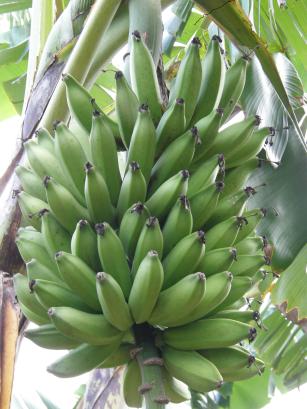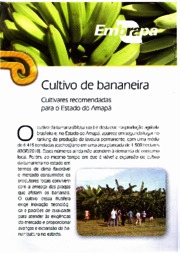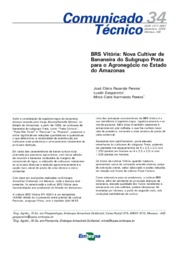Banana BRS Vitória
Banana BRS Vitória

Photo: CUNHA, Léa
Banana cultivar BRS Vitoria has as main characteristics resistance to black sigatoka, yellow sigatoka and panama disease. In addition, it is also resistant to post-harvest anthracnose. These characteristics make technology economically advantageous to producers. The cultivar also has high fruit quality, which gives it longer shelf life, making it more attractive from a commercial point of view. Productivity may exceed 44 tons per hectare from the second cycle on, under satisfactory cultivation conditions. The fruits of 'BRS Vitória', when ripe, have intense yellow peel, cream pulp, sweet taste and reduced acidity, in relation to the fruits of the cultivar Prata Comum. Such characteristics make this cultivar a product attractive to the consumer.
As an alternative for producers, the cultivar BRS Vitória, besides being resistant to the main banana diseases, is highly productive and meets the demand for bananas in the State of Amazonas. This cultivar presents good tillering, a high size similar to the cultivars of the Prata subgroup, and can be planted in spacings of 4m x 2.5m x 2.5m, with 1,230 plants per hectare, or 4m x 2.5m x 2.0m with 1,538 plants per hectare.
Panama disease (caused by F. oxysporum f. sp. cubense - Foc), as well as sigatokas, consist of the main diseases of banana farming, the damage of which represents, on average, losses of more than 50% of production in the affected areas. Black sigatoka is the most feared and aggressive, whose losses can reach 100% of the banana plantation if control is not carried out in a timely manner. Resistant varieties, such as BRS Vitoria, allow maintenance and, in some cases, the expansion of banana growing in areas whose incidence of these diseases was high.
What benefits do they have?
Banana producers, municipalities whose economy is mainly based on banana farming, retailers and consumers.
Geographical coverage
Northern region (above all), Northeast and north of Minas Gerais State.
Economic and social benefits
Due to the characteristics of banana production in the State of Amazon, practiced by small farmers, comprising low adoption of agricultural inputs and bananas groves located on the banks of water sources, the use of cultivars resistant to the main diseases and agronomically stable is the most feasible option from the technical and socio-environmental point of view.
The technology strengthens the recovery and/or maintenance of production indices, gross revenue and production stability; contributes to the decrease in the rural-to-urban migration flow and the maintenance of food security of populations whose consumption of bananas is a significant part of their food base. In addition, about 80% of banana producers are small family farming. Currently, banana plantation in the North region has resumed its viability and historical importance, mainly based on cultivars such as BRS Vitória.
Average increase in productivity: around 50%, considering losses caused by yellow and black sigatokas and panama disease in ‘caboclas’ and traditional varieties.
Estimated planted area of the set of BRS varieties resistant to black sigatoka and panama disease (Northern region - 2014): about 50,000 hectares.
Estimated gross value of production (North region - 2014): about R$ 550 million.
Where to find:
Essa cultivar é de domínio público e a Embrapa não controla a produção de sementes e mudas realizada por terceiros.
Product: Cultivar Launch year: 2005
Country: Brazil Region: North, Northeast, Southeast State: Acre, Amapá, Amazonas, Pará, Rondônia, Roraima, Tocantins, Alagoas, Bahia, Ceará, Maranhão, Paraíba, Pernambuco, Piauí, Rio Grande do Norte, Sergipe, Minas Gerais
Responsible Unit: Embrapa Cassava & Fruits
Participating Units: Embrapa Semi-arid Region, Embrapa Eastern Amazon, Embrapa Western Amazon, Embrapa Acre, Embrapa Amapá, Embrapa Rondônia, Embrapa Roraima
Keywords: Sigatoka, Resistência, mal-do-Panamá, Página Grandes Contribuições



